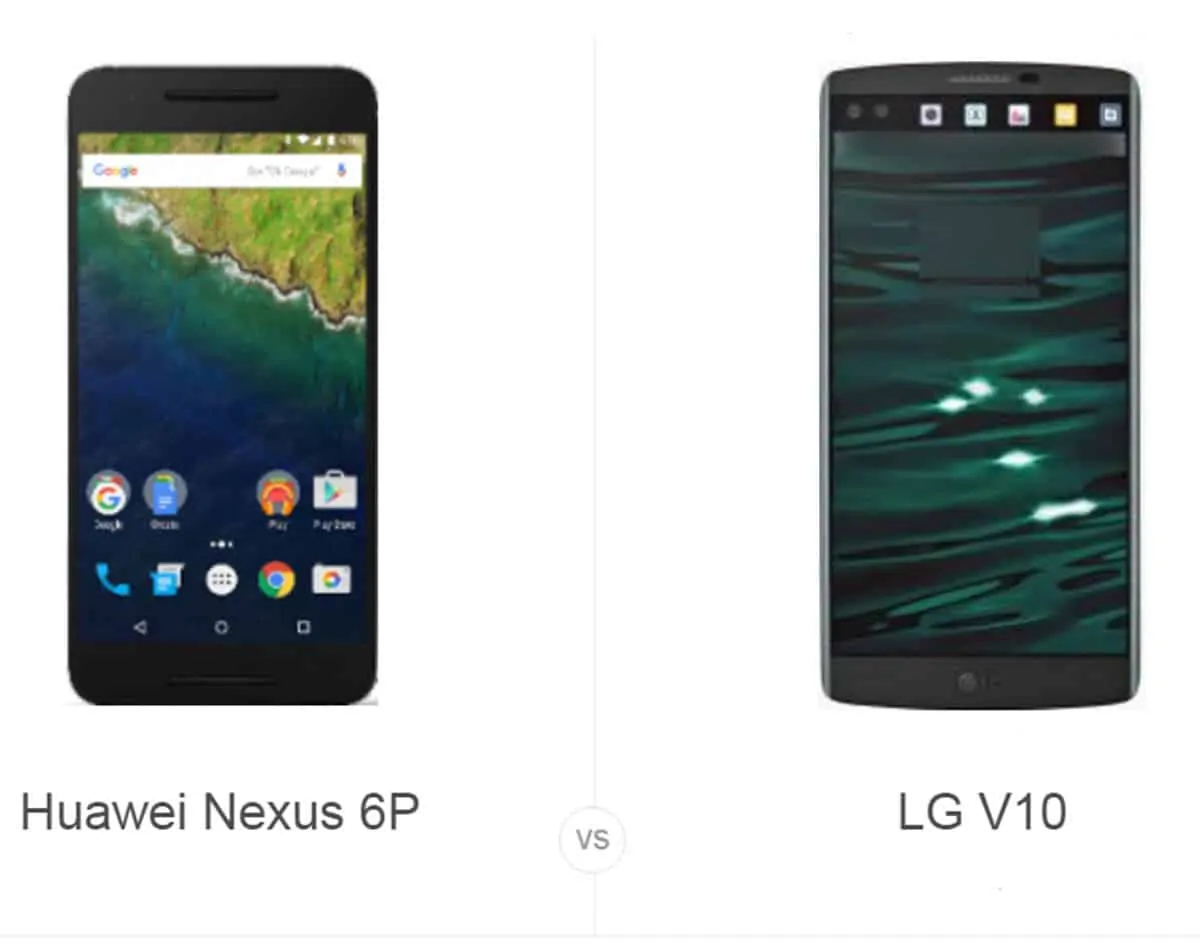Introduction
Do we have a good one for you today – the new, high-end all-metal Huawei Nexus 6P with its Android 6.0 Marshmallow goes up against the all-new stainless steel LG V10 with its mini display over top of the main display and its dual front-facing cameras (FFC). Both devices have a premium look and feel to them – the LG V10 looks unique with its silicone backing, adding great grip and protection from drops.
Let’s take a look at what these new devices have in common and then we will look at each individual device in more detail. These two smartphones have several specs that are very similar indeed – physical size for one thing. The Nexus 6P and the LG V10 are almost identical in height with the 6P at 159.3mm versus the 159.6mm on the V10…even their width is less than .2mm different. The LG V10 does weigh more at 192 grams versus 178 grams on the lighter Nexus 6P. While they use different display technology, they both sport 5.7-inch display and both have a Quad HD (QHD) display with 2560 x 1440 pixels. Both devices use a 64-bit Qualcomm Snapdragon, but different models. Both have excellent cameras and both sport a fingerprint sensor.
They both have the usual suspects – Wi-Fi, Bluetooth (v4.2 on the Nexus 6P and v4.1 on the LG V10), GPS, NFC capability, a microUSB port, with the newer reversible Type-C port on the Nexus 6P and they both have rapid charging capabilities.
Please take a deliberate look at the detailed Specifications Comparison chart below and there you will see just how these two great devices stack up against one another – click on the “View Full Comparison” link at the end of the chart to expand the details. After that, we will look at each individual device in greater detail and point out some of their pros and cons. From all of this information we will try to determine the winner based on specs and execution of design and functions.
Specifications
Huawei Nexus 6P
 The Huawei Nexus 6P, the more upscale of the two Nexus devices offered this year, is a real beauty and well-built device with an all-metal unibody construction. It is available in three colors – Aluminum, Graphite or Frost. It matches up very nicely to the LG V10 in components.
The Huawei Nexus 6P, the more upscale of the two Nexus devices offered this year, is a real beauty and well-built device with an all-metal unibody construction. It is available in three colors – Aluminum, Graphite or Frost. It matches up very nicely to the LG V10 in components.
Samsung produces the Nexus 6P’s 5.7-inch display, so you would be correct in guessing that it uses AMOLED technology. It is Quad HD (QHD) with a resolution of 2560 x 1440 pixels and 518 PPI. This compares to the 5.7-inch QHD IPS LCD display on the LG V10 with 515 PPI. Huawei decided to go with the 64-bit Qualcomm Snapdragon 810 octa-core processor, version 2.1. It has four cores clocked at 1.55 GHz and four cores clocked at 2.0 GHz. The LG V10 uses a 64-bit Snapdragon 808 hexa-core processor. The Nexus 6P has 3GB of RAM and a choice of 32GB, 64GB or 128GB of internal memory and has no means for external expansion. The V10 has 4GB of RAM and 64GB of internal memory, but can be expanded via a microSD card slot.
The camera on the Nexus 6P received high marks with DxOMark and did well in our own testing. It has a 12.3MP sensor, laser autofocus and dual-tone LED flash…but no OIS. This goes up against another good camera on the LG V10 – the same great camera found on the LG G4 – with a 16MP sensor, laser autofocus, dual-tone LED flash and OIS. The Nexus 6P has a large 8MP FFC for selfies and video chatting, while the LG V10 has dual 5MP FFCs for depth and special effects. The Nexus 6P has a large, 3450mAh non-removable battery that includes a rapid charge feature via its Type-C reversible plug. The LG V10 has a smaller 3000mAh removable battery with Quick Charge 2.0.
The Nexus 6P has a few features not found on the LG V10 – let’s start with the Samsung-built AMOLED QHD display. It has dual stereo front-facing speakers for better sound. Last, but certainly not least, it is running pure Android 6.0 Marshmallow and will always get the fastest upgrades possible when new versions come out. Pricing is at only $500 for the 32GB model and offers a great value.
LG V10
 LG always considered the G4 as their flagship device, but they just introduced a new device called the LG V10. It is a beautiful, though an unusual smartphone, in that it is sculpted from stainless steel and silicone that acts a means to protect the device from drops and also as a means for gripping the device. Secondly, it has two 5MP FFCs, and lastly, it has a small, independent display sitting ‘above’ the 5.7-inch main display, which can be on even when the main display is off. Exactly how the LG V10 will fit within this crowded field of premium devices remains to be seen…will users be thrilled with it or pass it up for the regular LG G4, a Samsung Galaxy S6 or one of the many other flagship devices available? Let’s take a closer look at the new LG V10 and see just how it stacks up against the new Huawei Nexus 6P.
LG always considered the G4 as their flagship device, but they just introduced a new device called the LG V10. It is a beautiful, though an unusual smartphone, in that it is sculpted from stainless steel and silicone that acts a means to protect the device from drops and also as a means for gripping the device. Secondly, it has two 5MP FFCs, and lastly, it has a small, independent display sitting ‘above’ the 5.7-inch main display, which can be on even when the main display is off. Exactly how the LG V10 will fit within this crowded field of premium devices remains to be seen…will users be thrilled with it or pass it up for the regular LG G4, a Samsung Galaxy S6 or one of the many other flagship devices available? Let’s take a closer look at the new LG V10 and see just how it stacks up against the new Huawei Nexus 6P.
Just as the Galaxy Note Edge that sported two displays – the main one and then the separate display off to the right – the LG V10 has two displays. The main display on the V10 is a 5.7-inch IPS Quantum QHD with a resolution of 2560 x 1440 pixels and 515 PPI, along with a 1040 x 160 pixel display that ‘sits’ above the top area of the main display. The secondary display can be ‘on’ while the main display is off, showing notifications, the weather, the time/date, app shortcuts and more. This goes up against the 5.7-inch QHD AMOLED display of the Nexus 6P with 518 PPI. LG chose the 64-bit Qualcomm Snapdragon 808 hexa-core processor with four cores clocked at 1.44 GHz and dual cores clocked at 1.82 GHz as the brains for the V10. The Nexus 6P is using the 64-bit, v2.1 Snapdragon 810 octa-core processor. The V10 is packing 4GB of RAM versus the Nexus 6P with 3GB of RAM. The LG V10 has only one option – 64GB of internal memory, but has a microSD card slot to expand another 128GB. The Nexus 6P gives you three options – 32GB, 64GB or 128GB – with no means to expand.
The main camera areas should be very competitive if the LG V10 lives up to its LG G4 heritage…we already know the Nexus 6P’s camera takes great pictures. The LG V10 uses a 16MP sensor with laser autofocus, a large f/1.8 aperture, OIS and an LED flash – the same, great camera found on the LG G4. The Nexus 6P uses a 12.3MP sensor, laser autofocus and a dual-tone LED Flash. The LG V10 uses a dual 5MP FFC to add a wider field and more depth to the traditional selfie or video chat. The Nexus 6P has the more traditional single 8MP FFC. The LG V10 uses a removable 3000mAh battery, while the Nexus 6P has a larger 3450mAh non-removable battery and both have a means for fast charging their batteries.
The LG V10 wisely includes a fingerprint sensor with the NFC that will allow the V10 to approve mobile payments, once the V10 gets its Android 6.0 Marshmallow update. The LG V10 has a speaker on the bottom of the device and includes Hi-Fi circuitry for improved sound through the headphones. The available colors are Space Black, Luxe White, Modern Beige, Ocean Blue and Opal Blue. It is available now on Verizon, AT&T and T-Mobile and priced approximately $675 – $700.
…And The Winner Is…

Summary
This was a rather tough one – the LG V10 does have a few features that offer more bling-bling than the Nexus 6P. I am talking about the dual display and the dual FFCs, but when you really look at purchasing one of these two devices, our minds have to focus on the entire package.
For my tastes, the Nexus 6P offers this entire package of build quality, looks, the newest software, faster processor, terrific camera, fingerprint sensor, QHD AMOLED display and you get all of this for a great price – not to mention unlocked and ready to work on all major US carriers. Because of this, I am picking the Nexus 6P as the winner of this comparison.
Do not get me wrong – the LG V10 is a work of art and a very worthy competitor, but if you take into account that entire package, the Nexus 6P just seems to offer a better value than the LG V10. If you like smartphones with a few extra technical features, practical or not, and don’t mind paying for them, then the LG V10 may be your choice. Either device should satisfy the more critical user.
[socialpoll id=”[socialpoll id=”2306147″]

